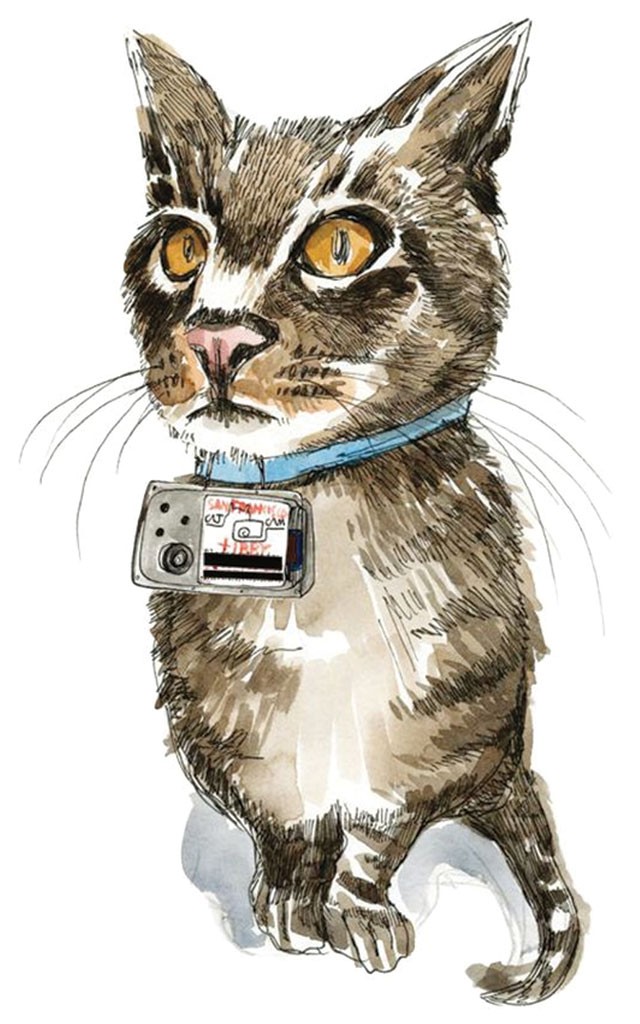LOST CAT
by Caroline Paul, with illustrations by Wendy MacNaughton | Bloomsbury USA | 176 pages
We struggle to define the nature of our love for our pets. It’s a relationship that’s often condescendingly called “uncomplicated” (which is probably due to the fact that animals can’t say unforgivable things to you, can’t borrow money, wreck your car or steal your boyfriend) – but that isn’t precisely true. It can be analogous to parenthood, but that’s also not the whole truth.
Caroline Paul’s latest book, Lost Cat: A True Story of Love, Desperation and GPS Technology, takes no such reductive approach. Her cats, Tibia and Fibula, are not her “babies,” nor generic fluffy creatures to “brighten the house” – they are fully formed and complex personages with whom she interacts, just like she does with any human. Fibby is the sociable one: “charming, smart, needy, the girl in middle school who ostracized fat kids and boys with bad skin, who whispered loudly behind people’s backs … and who, despite all this, was loved and envied by every classmate.” Tibby is fearful and shy: “the boy with the Coke-bottle glasses whose books were kicked into the mud daily.” This specificity of description will ring true to any pet owner.
Paul doesn’t come across as the stereotypical cat lady, yet her relationship to her cats is unashamedly all-consuming. When Tibby disappears, Paul is understandably overwrought and grief-stricken. Her self-tormenting fantasies of what might be keeping him away – “catnappers, vivisectionists … the hole he’s trapped in, the wounds that are keeping him from crawling home”; “Tibby with the rough-and-tumble feline crowd, drinking box wine in corners and throwing gang signs with [his] paws” – will ring familiar to anyone with an inconstant lover; the seesaw of gnawing worry versus injured doubt is universal to the left-behind. But when he returns, fat and happy, five weeks later, rather than simply being overjoyed by his return she spirals into an obsessive need to know just exactly where Tibby has been. Her fierce quest for the facts – in which she resorts to pet detectives, pet psychics, a GPS tracker and a tiny collar-mounted camera – is more than a little odd … but who hasn’t acted that weird or more so in the pursuit of love?
And that’s the crux of Lost Cat: Love is love, and every relationship has a unique internal logic, whether it’s with an animal or a human. As Paul eventually concludes, “You can never know anyone as completely as you want. But that’s OK, love is better.”
Cat’s-eye view
If, like Caroline Paul, you feel the deep need to know what your cat is up to when you’re not around, there’s an easy solution: video surveillance. Kitty collar-cams are readily available on Amazon, priced from $15 to $100 and promising a window into your pets’ private life. Some cat owners will, no doubt, be treated to a two-hour close-up of a cushion. Others – those whose pets go outside – may be horrified to realize how many birds and small animals their little loves are bloodying up out in the world; researchers at the University of Georgia found that 30 percent of cats they outfitted with cameras killed an average of two animals a week (and injured more).
These findings should be no surprise; after all, the cat-human bond formed thousands of years ago as a mutually beneficial relationship wherein the cats killed the rats attracted to humans’ stored grain (win-win for cats and humans; not so much for vermin). You may not be stockpiling wheat in your back yard, but your cat is still killing rats for you.


